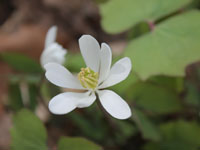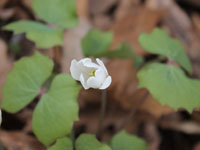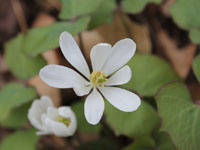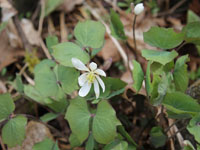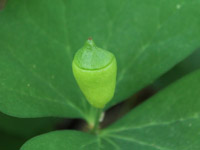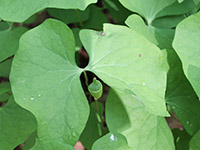![]()
Twinleaf is part of a small genus of plants, under the name jeffersonia, which is a member of the barberry family. Twinleaf is an uncommon spring wildflower which grows in limestone soils of rich deciduous forests. Jeffersonia was named for United States President Thomas Jefferson, by his contemporary Benjamin Smith Barton. This genus was formerly grouped in genus Podophyllum. Twinleaf is protected by state and provincial laws as a threatened or endangered plant in Georgia, Iowa, New York, and New Jersey. In 1800, Brickell used the name Jeffersonia to refer to some plants in the Loganiaceae, thus creating an illegitimate homonym.
![]()
Twinleaf has no commercial use.
![]() Within the realm of rational and holistic medicine, Native Americans still utilize twinleaf for a variety of medicines. The Cherokee use an infusion of this plant for treating dropsy, as well as gravel and urinary tract problems, as well as using it as a poultice for sores and inflammation. The Iroquois used a decoction of the plant to treat gall and diarrhea. The whole plant was used in early American medicine as an antispasmodic, diuretic, emetic, expectorant and general tonic. The "root" was once also used as an emetic in large doses, and as an expectorant in small doses.
Within the realm of rational and holistic medicine, Native Americans still utilize twinleaf for a variety of medicines. The Cherokee use an infusion of this plant for treating dropsy, as well as gravel and urinary tract problems, as well as using it as a poultice for sores and inflammation. The Iroquois used a decoction of the plant to treat gall and diarrhea. The whole plant was used in early American medicine as an antispasmodic, diuretic, emetic, expectorant and general tonic. The "root" was once also used as an emetic in large doses, and as an expectorant in small doses.
Please note that MIROFOSS does not suggest in any way that plants should be used in place of proper medical and psychological care. This information is provided here as a reference only.
![]()
Twinleaf is considered to be toxic and should not be used as a food source.
![]()
Twinleaf can grow in medium (silt) limestone soils and prefers well-drained soil. Twinleaf can grow in full shade or semi-shade It prefers moist soil. Twinleaf is known for attracting wildlife.
| Soil Conditions | |
| Soil Moisture | |
| Sunlight | |
| Notes: |
![]()
Twinleaf has smooth leaves and flowers which emerge directly from the rhizome at base of the plant. Twinleaf has showy white flowers with eight pedals which resemble a bloodroot flower. The short-lived flower appears in April or May, before the forest canopy appears as similar to most other spring ephemerals. The characteristic leaves are 7.5cm to 15cm long with a peltate shape, undulate margin, and with reticulate venation. The leaves are nearly divided in half, giving rise to its common name, twinleaf. Twinleaf rarely grows taller than 30cm at full maturity and after flowering contains a green pear-shaped capsule with a hinged top. The seeds are dispersed from the capsule by ants, a process known as myrmecochory.
![]()
| Plant Height | 20cm to 30cm | 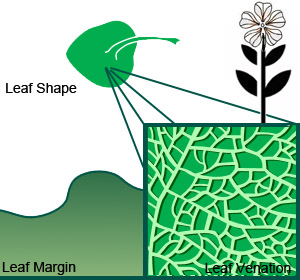 |
| Habitat | Rich deciduous woodlands with limestone soil | |
| Leaves | Peltate | |
| Leaf Margin | Undulate | |
| Leaf Venation | Reticulate | |
| Stems | Smooth Stems | |
| Flowering Season | April to May | |
| Flower Type | Radially Symmetrical | |
| Flower Colour | White | |
| Pollination | Bees, Insects | |
| Flower Gender | Flowers are hermaphrodite and the plants are self-fertile | |
| Fruit | Hard oval seeds | |
| USDA Zone | 4B (-28°C to -31°C) cold weather limit |
![]()
| The following health hazards should be noted when handling or choosing a location to plant twinleaf: | |
 |
TOXIC The roots of twinleaf contain berberine, a known anti-tumor alkaloid. The plant is therefore considered poisonous. |
![]()
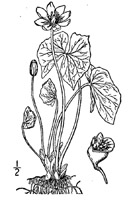 |
-Click here- or on the thumbnail image to see an artist rendering, from The United States Department of Agriculture, of twinleaf. (This image will open in a new browser tab) |
![]()
 |
-Click here- or on the thumbnail image to see a magnified view, from Eye On Nature, of the seeds created by twinleaf for propagation. (This image will open in a new browser tab) |
![]()
Twinleaf can be referenced in certain current and historical texts under one other name:
Mayapple canot be translated into any of the following select languages:
| Arabic | Bulgarian | Chinese (Sim) | |||
| Croatian | Czech | Danish | |||
| Dutch | Esperanto | Estonian | |||
| Finnish | French | German | |||
| Greek | Hebrew | Hungarian | |||
| Italian | Japanese | Korean | |||
| Punjabi | Lithuanian | Norwegian | |||
| Persian | Polish | Portuguese | |||
| Romanian | Russian | Slovak | |||
| Spanish | Swedish | Tagalog | |||
| Turkish | Ukrainian | Vietnamese |

![]()
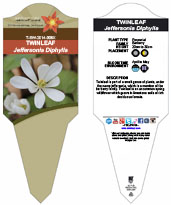 |
The MIROFOSS database offers free printable garden tags for personal and non-profit use. These tags can be used to properly identify plant samples in a garden. Click on the tags shown on the the screen or -click here- to download a full size jpeg image for a twinleaf identification tag; which can be printed on paper or used with a plastic laser printer. |
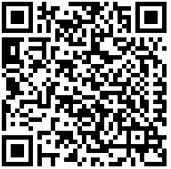 |
What's this? What can I do with it? |
![]()
| Description | Kartesz, J.T. 1994. A synonymized checklist of the vascular flora of the United States, Canada, and Greenland. 2nd edition. 2 vols. Timber Press, Portland, OR. |
| Description | Gleason, Henry A. and A. Conquest. 1991. Manual of Vascular Plants of Northeastern United States and Adjacent Canada. The New York Botanical Garden, Bronx, New York. 910 pp. |
| Description | Brumback, W.E., and L.J. Mehrhoff. 1996. Flora Conservanda: New England. The New England Plant Conservation Program list of plants in need of conservation. Rhodora 98 (895): 235-361 |
| Folklore | Hamel, Paul B. and Mary U. Chiltoskey 1975 Cherokee Plants and Their Uses -- A 400 Year History. Sylva, N.C. Herald Publishing Co. |
| Biology | Dickinson, T.; Metsger, D.; Bull, J.; & Dickinson, R. (2004) ROM Field Guide to Wildflowers of Ontario. Toronto:Royal Ontario Museum, |
| Image Rendering | USDA-NRCS PLANTS Database / USDA NRCS. Wetland flora: Field office illustrated guide to plant species. USDA Natural Resources Conservation Service. |
| Environment | National Audubon Society. Field Guide To Wildflowers (Eastern Region): Alfred A. Knopf. ISBN 0-375-40232-2 |
| Physical Identification | National Audubon Society. Field Guide To Wildflowers (Eastern Region): Alfred A. Knopf. ISBN 0-375-40232-2 |
| October 03, 2015 | The last time this page was updated |
| ©2021 MIROFOSS™ Foundation | |
 |
|

